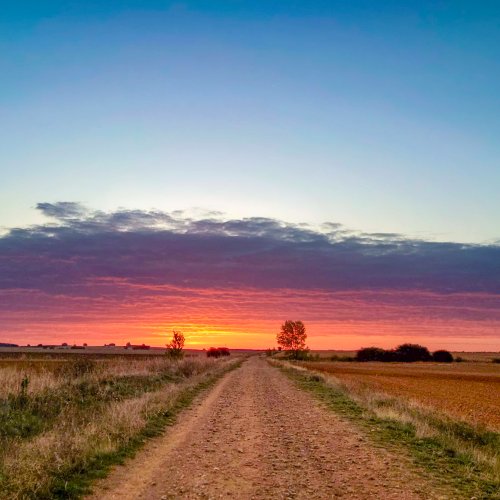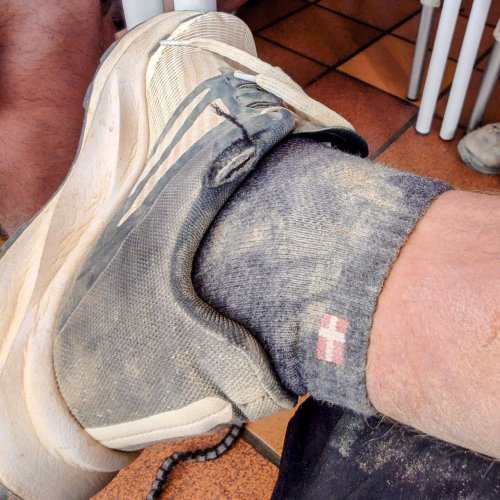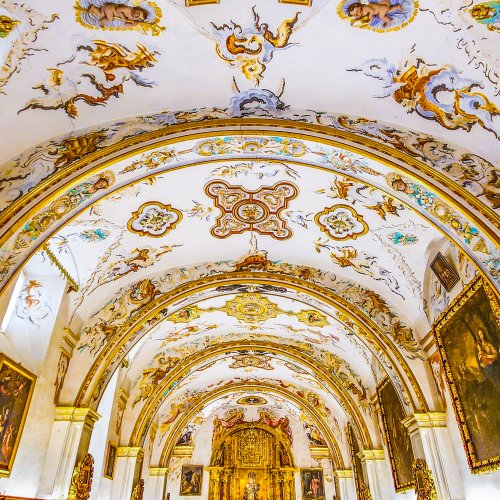- Time of past OR future Camino
- all
We have now completed the Camino Mozarabe, walking from Almeria to Merida. Gerard and I documented our walk, in English and Dutch, in our Find Penguins blog, which you can access here:
https://findpenguins.com/50kui6mow4grm/trip/65c5044d839277-46917355
We enthusiastically recommend the Camino Mozarabe and are happy to now be part of what Peregrina2000 refers to as the ‘Mozarabe Mob’, although there are a number of considerations that peregrinos should be aware of before they take on this sometimes demanding route. We want to draw your attention to some of the pros and cons.
We must begin with a big warm thanks to Nely (definitely a pro!), who provides peregrinos with a very generous welcome and introduction to the CM from the Albergue in her home. We are very sorry to hear that she may be closing her Albergue… Such a loss to the CM! We also want to thank the Forum members who virtually accompanied us on our walk, via the Find Penguins app. We received some very helpful advice, both on the Forum and Find Penguins. This Forum is indispensable!
The early days of the walk, through and alongside the Sierra Nevada, were extraordinarily beautiful, although definitely challenging, given the endless climbs and descents. We found ourselves relieved to stop walking after a 20 km day, a distance that would have been a warm up on our CFs or the VdLP. Perhaps we did not begin in our best physical condition? Regardless, we were feeling tired but strong by the time we reached Merida!
The CM is set up to receive many more peregrinos than currently walk it. The arrows and signposts are plentiful, and there seems to be a celebration/promotion of the route that greets peregrinos along the way. There is clearly some EU money going into creating the infrastructure. Everyone we encountered was really kind to us, doing their best to be helpful, even with our limited Spanish. They want us!
And the albergues! This is a route where you should consider choosing the municipal albergues over the private hostals. Most were spacious and clean, and provided an opportunity to prepare food and wash clothing. They were typically cold (not surprising in February-March), but space heaters were provided that warmed things up nicely. Sometimes there were broken toilet seats, an absence of soap, no disposable sheets, and sketchy cleaning, but we encountered similar limitations in some private hostal accommodations. Usually Gerard and I were alone in the albergues. We did not meet any other peregrinos until after Granada, and then not many of them.
We did, however, encounter a lot of dogs, and found that the CM dogs were mainly lovely creatures, unlike the awful beasts we encountered along the Camino Serrana at this time last year. We feel much better about meeting dogs along the way now, although the amount of dog shit in many villages was extraordinary. You must watch every step!
Now for the cautions. This is a route that you must be well-prepared to take on. On many days you must carry food with you for lunch and dinner, plus energy snacks and lots of water, because you will not encounter a village, and if you do there is a good chance that nothing will be open. Most mornings we could find a bar open for coffee con leche and a tostada. Yay! If you are considering walking the CM you have likely walked other camino routes and have some familiarity with Spanish eating, resting, and working patterns, and frequent holidays. There were many days when we searched in vain for a little tienda or bar open in the mid-afternoon or evening. Evenings were the most challenging, given that in Spain the main meal of the day is mid-day (when we would still be walking), and restaurants do not open for dinner…. If they open at all… until after 8:30 pm. You will not find pilgrim menus/time considerations on the CM.
There was not a lot of camaraderie, outside of the cities. We were able to have meals or drinks only twice with other peregrinos (people walking a bit later in the season will of course have more company), but more significantly, we could find no active public spaces in the towns along the way, other than a handful of men in a local bar. Perhaps it was also the time of year?
If you are not a ‘walk every step’ peregrino, we suggest skipping the day after Granada, as AndrewG recommended. It’s a boring industrial stretch where you walk entirely on pavement. There is a bus (225) to Pinos Puente. After several km, you will begin a steep but stunning climb to Moclin. This is the last day that presents a challenging ascent. After Moclin, the route becomes less demanding, but the trade off is that the route is also less beautiful. Still, we enjoyed walking through olive groves, farmland, natural areas, and fields of lovely flowers that were happily already in bloom. While more ordinary than the first days of the CM, this section was nonetheless rewarding. The CM, for us, only became uninteresting after La Haba, when the days were mainly just a means to get to our destination, Merida. There was a lot of pavement and walking on or near highways. We listened to music and podcasts to pass the time (except on busy highways, where we needed to have full use of our senses).
We were super fortunate with the weather, particularly given the time of year. Mornings were cool, and for the first two weeks, by the afternoon very warm (too warm!). The temperature moderated later, which was much nicer for walking. We had only a few days of rain, including a day with very strong winds and driving rain that turned my boots into ponds, and another day with driving rain that changed to driving hail, then sun, then repeat. People who began the CM two weeks after us were not so fortunate, with freezing temperatures and sometimes snow. It’s the luck of the draw, but we would certainly recommend a February-March walk over the following months, unless you love very hot weather. The flowers in bloom alone will bring cheer to your days.
Something we would do differently, in retrospect, is to have more rest days, making time to explore more of the towns that we passed through. We only took one rest day, in Granada, and I took a cab one day when I was ill. We say this to ourselves with every camino, but when we are en route, we seem to want to keep moving forward.
There is a lot more detail (and photos) on our Find Penguin blog. We can also try to answer any questions that you may have on this forum, and no doubt other CM fans will pitch in. We hope you will decide that this route is for you!
~debi and Gerard
https://findpenguins.com/50kui6mow4grm/trip/65c5044d839277-46917355
We enthusiastically recommend the Camino Mozarabe and are happy to now be part of what Peregrina2000 refers to as the ‘Mozarabe Mob’, although there are a number of considerations that peregrinos should be aware of before they take on this sometimes demanding route. We want to draw your attention to some of the pros and cons.
We must begin with a big warm thanks to Nely (definitely a pro!), who provides peregrinos with a very generous welcome and introduction to the CM from the Albergue in her home. We are very sorry to hear that she may be closing her Albergue… Such a loss to the CM! We also want to thank the Forum members who virtually accompanied us on our walk, via the Find Penguins app. We received some very helpful advice, both on the Forum and Find Penguins. This Forum is indispensable!
The early days of the walk, through and alongside the Sierra Nevada, were extraordinarily beautiful, although definitely challenging, given the endless climbs and descents. We found ourselves relieved to stop walking after a 20 km day, a distance that would have been a warm up on our CFs or the VdLP. Perhaps we did not begin in our best physical condition? Regardless, we were feeling tired but strong by the time we reached Merida!
The CM is set up to receive many more peregrinos than currently walk it. The arrows and signposts are plentiful, and there seems to be a celebration/promotion of the route that greets peregrinos along the way. There is clearly some EU money going into creating the infrastructure. Everyone we encountered was really kind to us, doing their best to be helpful, even with our limited Spanish. They want us!
And the albergues! This is a route where you should consider choosing the municipal albergues over the private hostals. Most were spacious and clean, and provided an opportunity to prepare food and wash clothing. They were typically cold (not surprising in February-March), but space heaters were provided that warmed things up nicely. Sometimes there were broken toilet seats, an absence of soap, no disposable sheets, and sketchy cleaning, but we encountered similar limitations in some private hostal accommodations. Usually Gerard and I were alone in the albergues. We did not meet any other peregrinos until after Granada, and then not many of them.
We did, however, encounter a lot of dogs, and found that the CM dogs were mainly lovely creatures, unlike the awful beasts we encountered along the Camino Serrana at this time last year. We feel much better about meeting dogs along the way now, although the amount of dog shit in many villages was extraordinary. You must watch every step!
Now for the cautions. This is a route that you must be well-prepared to take on. On many days you must carry food with you for lunch and dinner, plus energy snacks and lots of water, because you will not encounter a village, and if you do there is a good chance that nothing will be open. Most mornings we could find a bar open for coffee con leche and a tostada. Yay! If you are considering walking the CM you have likely walked other camino routes and have some familiarity with Spanish eating, resting, and working patterns, and frequent holidays. There were many days when we searched in vain for a little tienda or bar open in the mid-afternoon or evening. Evenings were the most challenging, given that in Spain the main meal of the day is mid-day (when we would still be walking), and restaurants do not open for dinner…. If they open at all… until after 8:30 pm. You will not find pilgrim menus/time considerations on the CM.
There was not a lot of camaraderie, outside of the cities. We were able to have meals or drinks only twice with other peregrinos (people walking a bit later in the season will of course have more company), but more significantly, we could find no active public spaces in the towns along the way, other than a handful of men in a local bar. Perhaps it was also the time of year?
If you are not a ‘walk every step’ peregrino, we suggest skipping the day after Granada, as AndrewG recommended. It’s a boring industrial stretch where you walk entirely on pavement. There is a bus (225) to Pinos Puente. After several km, you will begin a steep but stunning climb to Moclin. This is the last day that presents a challenging ascent. After Moclin, the route becomes less demanding, but the trade off is that the route is also less beautiful. Still, we enjoyed walking through olive groves, farmland, natural areas, and fields of lovely flowers that were happily already in bloom. While more ordinary than the first days of the CM, this section was nonetheless rewarding. The CM, for us, only became uninteresting after La Haba, when the days were mainly just a means to get to our destination, Merida. There was a lot of pavement and walking on or near highways. We listened to music and podcasts to pass the time (except on busy highways, where we needed to have full use of our senses).
We were super fortunate with the weather, particularly given the time of year. Mornings were cool, and for the first two weeks, by the afternoon very warm (too warm!). The temperature moderated later, which was much nicer for walking. We had only a few days of rain, including a day with very strong winds and driving rain that turned my boots into ponds, and another day with driving rain that changed to driving hail, then sun, then repeat. People who began the CM two weeks after us were not so fortunate, with freezing temperatures and sometimes snow. It’s the luck of the draw, but we would certainly recommend a February-March walk over the following months, unless you love very hot weather. The flowers in bloom alone will bring cheer to your days.
Something we would do differently, in retrospect, is to have more rest days, making time to explore more of the towns that we passed through. We only took one rest day, in Granada, and I took a cab one day when I was ill. We say this to ourselves with every camino, but when we are en route, we seem to want to keep moving forward.
There is a lot more detail (and photos) on our Find Penguin blog. We can also try to answer any questions that you may have on this forum, and no doubt other CM fans will pitch in. We hope you will decide that this route is for you!
~debi and Gerard

















